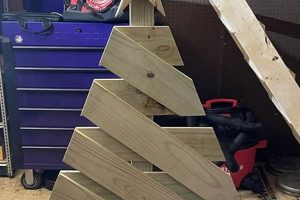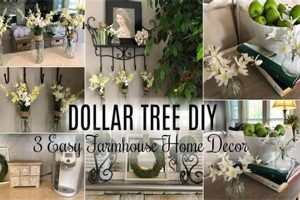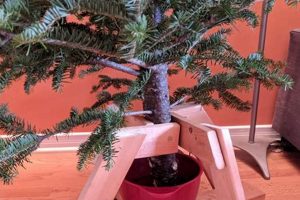The creation of customized circular barriers around trees, often referred to as do-it-yourself tree surrounds, represents a practical and aesthetic approach to landscaping. These structures can delineate the space around a tree, offering protection from lawnmowers and foot traffic while simultaneously enhancing visual appeal. Common examples include constructing these features from materials like brick, stone, wood, or recycled materials.
Implementing these structures provides multiple advantages. They safeguard the tree trunk from mechanical damage, help retain soil moisture, and can prevent soil compaction around the root zone. Historically, the practice of surrounding trees with protective borders has been employed in both formal gardens and practical agricultural settings, demonstrating an enduring value in landscape design and tree care. The benefits extend to improved tree health and longevity, alongside an increase in property value due to enhanced curb appeal.
Following sections will detail various material choices, construction techniques, and design considerations for crafting durable and visually appealing tree surrounds. Exploration of options from simple, budget-friendly approaches to more elaborate and decorative installations will be included. Emphasis will be placed on safety and long-term tree health in all presented methods.
Effective Approaches to Tree Surround Construction
The following guidelines provide actionable insights for constructing functional and aesthetically pleasing tree surrounds. Careful consideration of these points ensures both the longevity of the structure and the health of the tree.
Tip 1: Material Selection: Choose materials that complement the existing landscape and are resistant to weathering. Options include treated lumber, natural stone, recycled plastic composites, or durable brick.
Tip 2: Diameter Determination: Establish the appropriate diameter for the surround based on the mature size of the tree. A minimum diameter of three feet is recommended to accommodate future growth.
Tip 3: Root Zone Consideration: Avoid disturbing the root zone during excavation. If large roots are encountered, adjust the surround’s placement or modify the design to minimize damage.
Tip 4: Proper Drainage: Ensure adequate drainage within the surround to prevent waterlogging and root rot. Incorporate gravel or a permeable landscape fabric beneath the topsoil.
Tip 5: Secure Construction: Utilize appropriate fasteners and construction techniques to ensure the surround’s stability and prevent collapse. Mortar joints in stone or brick structures should be properly sealed.
Tip 6: Mulch Application: Apply a layer of organic mulch within the surround to retain moisture, suppress weeds, and regulate soil temperature. Avoid piling mulch directly against the tree trunk.
Tip 7: Regular Maintenance: Inspect the surround periodically for damage or deterioration. Repair cracks, replace damaged materials, and remove any accumulated debris.
Adherence to these tips promotes successful construction, leading to enhanced aesthetic appeal and long-term tree health. Prioritizing proper planning and execution mitigates potential issues and ensures a lasting addition to the landscape.
The succeeding section will address common pitfalls and preventative measures to consider during the building process.
1. Material Durability
The longevity and functionality of do-it-yourself tree surrounds are intrinsically linked to the durability of the materials employed in their construction. Material selection directly impacts the structure’s resistance to environmental stressors, including temperature fluctuations, moisture exposure, and physical impact. The cause-and-effect relationship is evident: using durable materials leads to a prolonged lifespan and reduced maintenance needs, while selecting less robust options results in premature degradation and potential structural failure. The importance of material durability in the context of DIY tree rings cannot be overstated, as it dictates the overall effectiveness of the surround in protecting the tree and enhancing the landscape. For example, pressure-treated lumber or natural stone offer significantly greater resistance to rot and weathering compared to untreated wood or porous materials, leading to a longer-lasting and more effective tree surround. This understanding has practical significance for homeowners and landscapers, as it informs informed decision-making during the material selection process.
Further analysis reveals the practical implications of material durability across diverse environmental conditions. In regions with heavy rainfall, materials must exhibit exceptional resistance to water damage and fungal growth. Coastal areas necessitate the use of corrosion-resistant materials due to saltwater exposure. Climates characterized by extreme temperature variations require materials that can withstand expansion and contraction without cracking or warping. Consider, for example, the use of recycled plastic lumber, which offers superior resistance to moisture, insects, and UV degradation compared to traditional wood products. This material choice not only extends the lifespan of the tree surround but also reduces the environmental impact through the utilization of recycled materials.
In summary, the selection of durable materials is a crucial determinant of the success and longevity of DIY tree rings. The correlation between material durability and the long-term performance of these structures is undeniable. While cost considerations may influence material choices, prioritizing durability ultimately leads to reduced maintenance costs, improved aesthetics, and enhanced protection for the tree. Overlooking this aspect may result in structural instability and frequent repairs, thereby undermining the intended purpose of the tree surround and negating any initial cost savings. The challenge lies in balancing affordability with durability to achieve an optimal outcome for both the tree and the landscape.
2. Structural Integrity
The concept of structural integrity is paramount when considering do-it-yourself tree surrounds. This principle ensures that the constructed element can withstand environmental forces and usage stresses without compromising its form or function. The stability and longevity of tree surrounds are directly dependent on sound structural design and execution.
- Foundation Stability
The foundation serves as the base upon which the entire structure rests. Instability at this level can lead to cracking, tilting, or complete collapse of the tree surround. Proper foundation construction involves assessing soil conditions, potentially incorporating a compacted gravel base, and ensuring adequate drainage to prevent erosion or frost heave. Failure to address these factors can result in premature structural failure. Examples include using a leveling base of packed gravel for brick surrounds, or a concrete footing for stacked stone walls.
- Material Interlocking and Bonding
The manner in which individual components of the surround are connected significantly impacts its overall strength. Mortar in brick or stone structures provides adhesion and distributes loads. Interlocking designs, such as those found in some modular block systems, enhance stability by creating a unified structure. Inadequate bonding can lead to separation of elements, weakening the surround. A practical application can involve using a high-quality mortar mix with appropriate additives for freeze-thaw resistance in colder climates.
- Lateral Support and Reinforcement
Lateral forces, such as soil pressure or accidental impacts, can cause the surround to deform or collapse inward. Incorporating lateral support elements, such as backfilling with compacted gravel or using reinforcing materials within the structure, can significantly increase its resistance to these forces. The absence of lateral support can lead to bowing or instability, particularly in taller surrounds. This element is often addressed by slightly angling the walls of the tree surround, allowing for better resistance to pressure and increasing overall stability.
- Drainage Provisions
Water accumulation behind the surround can exert significant hydrostatic pressure, potentially leading to structural damage. Implementing drainage provisions, such as weep holes or a gravel backfill, allows water to escape, reducing the risk of failure. Neglecting drainage can lead to waterlogged soil and increased lateral pressure against the surround. For example, installing a perforated drain pipe behind the surround connected to a suitable outlet will allow for efficient water runoff and prevent pressure buildup.
These facets underscore the importance of a comprehensive approach to structural integrity in the construction of DIY tree surrounds. A stable foundation, proper interlocking of materials, adequate lateral support, and effective drainage collectively ensure that the structure can withstand environmental stresses and provide lasting protection for the tree. Integrating these considerations from the outset is critical for achieving a durable and aesthetically pleasing result. Conversely, neglecting one or more of these areas can compromise the entire project, leading to costly repairs or complete failure.
3. Root Protection
Safeguarding the root system of a tree constitutes a critical consideration when undertaking the construction of do-it-yourself tree surrounds. Improper construction practices can inflict damage to the roots, compromising the tree’s health and stability. The following outlines essential facets of root protection within the context of designing and implementing tree surrounds.
- Excavation Depth and Proximity
Excavation for the surround’s foundation should be performed with minimal disturbance to the underlying root structure. Roots located close to the surface are particularly vulnerable to damage during digging. Maintaining a reasonable distance from the tree’s trunk during excavation, and limiting the depth of digging, minimizes the risk of root severance or compaction. Practical application involves carefully removing topsoil layers by hand around the tree’s base, avoiding the use of heavy machinery that could compact the soil and damage shallow roots. It’s imperative to consider tree size when doing DIY tree ring ideas. For example, the presence of large roots can mandate adjustments to the design to avoid damaging them.
- Material Permeability and Gas Exchange
The selection of materials for the tree surround influences the soil’s capacity to retain moisture and facilitate gas exchange, both of which are vital for root health. Impermeable materials can impede water infiltration and restrict the flow of oxygen to the roots, leading to anaerobic conditions and potential root rot. Opting for porous materials or incorporating drainage elements within the surround promotes a healthy root environment. The use of porous paving stones or gravel as a surface material can provide a stable and aesthetically pleasing surface, while still allowing water and air to reach the roots. The use of gravel can depend on the tree’s needs for drainage, which varies based on the species.
- Compaction Mitigation Strategies
Soil compaction resulting from construction activities can significantly impede root growth and function. Compacted soil restricts root penetration, limits water and nutrient uptake, and reduces gas exchange. Employing strategies to mitigate compaction, such as using lightweight equipment, distributing weight with plywood sheets, and amending the soil with organic matter, helps preserve the soil’s structure and promote healthy root development. Aerating the soil around the tree’s root zone before constructing the surround can help alleviate existing compaction and improve conditions for new root growth. This process can be done using a manual aerator, or an auger, in accordance to the tree’s overall needs.
- Preventing Physical Damage
Tree surrounds should be designed and constructed to prevent physical damage to the trunk and roots from lawnmowers, foot traffic, and other external factors. The surround serves as a protective barrier, shielding the tree from accidental impacts. The size and placement of the surround should be adequate to provide a sufficient buffer zone around the tree. Integrating a raised edge or lip on the surround can further enhance its protective function. Additionally, using soft materials in the surrounding, like mulch, can reduce injury in high traffic areas around the tree.
These interrelated facets underscore the importance of prioritizing root protection in the design and construction of tree surrounds. By carefully considering excavation practices, material permeability, compaction mitigation, and physical damage prevention, one can create a functional and aesthetically pleasing surround that safeguards the tree’s health and ensures its long-term survival. Conversely, neglecting these aspects can compromise the tree’s well-being, potentially leading to decline or mortality. A comprehensive understanding of root physiology and sensitivity is, therefore, essential for successful tree surround implementation.
4. Drainage Efficiency
Drainage efficiency is a critical factor in the successful implementation of do-it-yourself tree surrounds. Proper drainage prevents waterlogging, which can lead to root rot and other detrimental conditions affecting tree health. The design and construction of tree surrounds must, therefore, incorporate elements that facilitate effective water runoff and soil aeration.
- Soil Permeability Considerations
The inherent permeability of the soil surrounding the tree directly impacts drainage. Clay-rich soils retain more water and impede drainage, whereas sandy soils drain more rapidly. The design of the tree surround should account for these soil characteristics. In areas with heavy clay soils, amending the soil with organic matter or installing a drainage layer beneath the surround can improve water infiltration. Examples of such amendments are sand and other drainage materials to increase drainage capacity. The implications of poorly permeable soil and improper planning can lead to waterlogged conditions, root damage, and eventually, tree decline.
- Surface Grading and Slope
The grading and slope of the land surrounding the tree surround significantly influence water runoff. A properly graded surface directs water away from the tree’s base, preventing water from pooling within the surround. Creating a slight slope away from the tree trunk during construction ensures that excess water is effectively channeled away. Insufficient grading can result in water accumulating around the trunk, increasing the risk of root rot. This principle is important for DIY tree ring ideas because improper implementation can quickly threaten the plant’s health.
- Material Selection and Porosity
The choice of materials used in the construction of the tree surround affects drainage efficiency. Impermeable materials, such as solid concrete or tightly fitted stones, can impede water flow, while porous materials, such as gravel or loosely arranged pavers, allow for better drainage. Selecting materials that promote water infiltration contributes to a healthier root environment. An example of material selection improving porosity is using pea gravel for the inner layering of the tree ring rather than a solid slab of concrete, improving DIY tree ring ideas’ drainage system.
- Installation of Drainage Systems
In areas with poor drainage or high rainfall, the installation of a dedicated drainage system may be necessary. This can involve incorporating a subsurface drainage system, such as a French drain, to redirect excess water away from the tree’s root zone. Alternatively, weep holes can be strategically placed within the surround to allow water to escape. Proper installation ensures that the drainage system effectively manages water runoff, preventing waterlogging and promoting healthy root growth. For example, incorporating a French drain, or other drainage system, is an important upgrade depending on the DIY tree ring ideas and the surrounding environment.
The interplay of these components determines the overall drainage efficiency of the tree surround. Addressing soil permeability, surface grading, material selection, and the potential need for a dedicated drainage system is crucial for creating a healthy environment for the tree’s root system. A comprehensive approach to drainage efficiency mitigates the risk of waterlogging, promotes root health, and contributes to the long-term survival and vitality of the tree. Therefore, any DIY tree ring ideas must consider all of these elements to be successful.
5. Aesthetic Harmony
Achieving aesthetic harmony is a pivotal element in the successful implementation of do-it-yourself tree surrounds. The visual integration of the tree surround with the surrounding landscape contributes significantly to the overall appeal and property value. A disconnect between the surround’s design and the existing aesthetic can detract from the landscape’s beauty, negating the benefits of protecting the tree. The cause-and-effect relationship is clear: thoughtfully designed and constructed surrounds enhance visual appeal, while poorly conceived designs diminish it. Aesthetic harmony, therefore, constitutes a critical component of well-executed DIY tree ring ideas. For example, a rustic stone surround complements a natural, informal garden, whereas a sleek, modern design aligns better with a contemporary landscape. The practical significance lies in understanding the interplay between design elements and the existing environment to achieve a cohesive and pleasing visual effect.
Further analysis reveals the multifaceted nature of aesthetic harmony in the context of tree surrounds. Consideration must be given to material selection, color palettes, and the overall form of the structure. The materials should complement the surrounding vegetation and architectural elements. The color palette should harmonize with the existing landscape colors. The form of the surroundwhether circular, square, or irregularshould align with the overall design principles of the garden. A formal garden, for instance, might benefit from a symmetrical, precisely crafted surround, while a more relaxed, informal setting could accommodate a more organic, free-flowing design. Practical applications include using locally sourced materials to create a sense of place, incorporating native plants around the surround to soften its edges, and ensuring that the surround’s height and scale are proportionate to the size of the tree and the surrounding landscape. Poorly executed DIY tree ring ideas can significantly reduce curb appeal, resulting in negative perceptions of the property.
In summary, aesthetic harmony is a critical determinant of the success and value of DIY tree ring ideas. The visual integration of the surround with the surrounding landscape is essential for achieving a pleasing and cohesive result. While personal preferences play a role, a thoughtful and informed approach to design, material selection, and construction is necessary to ensure that the tree surround enhances, rather than detracts from, the overall aesthetic. Challenges arise in balancing personal tastes with objective design principles and adapting to the unique characteristics of each landscape. However, prioritizing aesthetic harmony ultimately contributes to a more visually appealing and valuable property.
6. Maintenance Accessibility
Maintenance accessibility, in the context of do-it-yourself tree surrounds, refers to the ease with which the structure and surrounding area can be inspected, cleaned, repaired, and generally maintained. This factor directly influences the long-term functionality and aesthetic appeal of the installation, and should be a primary consideration during the design and construction phases.
- Debris Removal and Cleaning
The design should facilitate the removal of fallen leaves, twigs, and other debris that accumulate within the surround. Inaccessible areas can become breeding grounds for pests and diseases, potentially affecting the tree’s health. A surround with ample open space and minimal obstructions allows for efficient cleaning, preserving both the tree’s health and the surround’s appearance. Examples include designing a surround with smooth surfaces and avoiding overly intricate designs that trap debris. A practical consideration is the use of a leaf blower or vacuum within the surround, which requires sufficient maneuvering space.
- Inspection for Structural Integrity
Regular inspection of the surround’s structural components is essential for identifying and addressing potential issues before they escalate. A design that allows for easy visual inspection of the foundation, joints, and materials enables timely detection of cracks, erosion, or other forms of deterioration. Inaccessible areas can conceal damage, leading to more extensive and costly repairs. For instance, surrounds constructed with interlocking blocks should permit easy removal and replacement of individual blocks for inspection and maintenance. It also important to inspect for pest like termites that can harm the surround or the tree.
- Soil and Mulch Management
The ability to easily access and manage the soil and mulch within the surround is crucial for maintaining proper soil health and moisture levels. Designs that impede access to the soil can hinder the application of fertilizers, the removal of weeds, and the replenishment of mulch. A surround with an open design or removable sections allows for convenient soil management, promoting healthy root growth. Practical examples include surrounds with segmented construction that allows sections to be easily lifted for soil amendment or designs that permit access with a small gardening trowel.
- Repair and Modification Accessibility
The design should accommodate future repairs or modifications to the surround without requiring extensive dismantling or specialized tools. A modular design or the use of readily available materials simplifies the repair process. Inaccessible components can necessitate time-consuming and costly repairs. For example, a surround constructed with readily available brick or stone allows for easy replacement of damaged elements. This facet is important because tree surrounds, despite proper planning, are susceptible to damages and degradation.
These interconnected facets underscore the importance of maintenance accessibility in the design and construction of DIY tree surrounds. A well-designed surround not only enhances the aesthetic appeal of the landscape and protects the tree but also simplifies the long-term maintenance required to preserve its functionality and appearance. Conversely, a design that neglects maintenance accessibility can lead to increased maintenance costs, reduced tree health, and a diminished aesthetic value. The consideration and implementation of maintenance accessibility are therefore crucial for the sustained success of DIY tree ring ideas.
Frequently Asked Questions Regarding DIY Tree Ring Ideas
The following section addresses common inquiries and concerns related to the design, construction, and maintenance of do-it-yourself tree surrounds. This information aims to provide clarity and guidance for individuals undertaking such projects.
Question 1: What is the optimal material for constructing a tree surround in a region with harsh winters?
The optimal material for constructing a tree surround in a region with harsh winters should exhibit high resistance to freeze-thaw cycles. Natural stone, pressure-treated lumber, or recycled plastic composites are suitable options. These materials withstand repeated freezing and thawing without significant degradation. Avoid materials that are prone to cracking or water absorption, as these will deteriorate rapidly in cold climates.
Question 2: How far from the tree trunk should a tree surround be placed?
A tree surround should be placed at a distance that avoids constricting the tree’s root flare and allows for future trunk growth. A general guideline is to maintain a minimum clearance of 6-12 inches between the trunk and the inner edge of the surround. For younger trees, this distance should be increased to accommodate their anticipated growth. Monitoring the tree’s growth over time and adjusting the surround’s size as needed is advisable.
Question 3: What is the recommended depth for excavating the foundation of a tree surround?
The depth of excavation for a tree surround foundation should be minimized to prevent damage to the tree’s root system. A depth of 4-6 inches is generally sufficient for providing a stable base. Care should be taken to avoid severing or damaging any major roots encountered during excavation. If large roots are present, the surround’s design may need to be modified to accommodate them.
Question 4: How can proper drainage be ensured within a tree surround?
Proper drainage within a tree surround can be ensured by incorporating several design elements. These include a gravel base beneath the surround, weep holes in the structure, and a slightly sloped surface to direct water away from the tree trunk. The soil within the surround should also be well-draining to prevent waterlogging. Amending heavy clay soils with organic matter can improve drainage.
Question 5: What is the best type of mulch to use within a tree surround?
The best type of mulch to use within a tree surround is an organic mulch, such as shredded bark, wood chips, or pine straw. Organic mulches retain moisture, suppress weeds, and gradually decompose, enriching the soil. Avoid using inorganic mulches, such as rocks or gravel, as these can compact the soil and impede drainage. Mulch should be applied in a layer 2-4 inches thick, keeping it several inches away from the tree trunk to prevent rot.
Question 6: How often should a tree surround be inspected and maintained?
A tree surround should be inspected and maintained at least once a year, preferably in the spring. This inspection should include checking for structural damage, erosion, pest infestations, and excessive debris accumulation. Repairs should be made promptly to prevent further deterioration. Mulch should be replenished as needed to maintain a consistent depth and weed suppression.
These answers provide a foundational understanding of key considerations for DIY tree surrounds. Implementing these guidelines contributes to the long-term health and aesthetic appeal of the project.
The subsequent section will delve into potential design variations and creative applications for tree surrounds.
Concluding Remarks
This exploration of DIY tree ring ideas has presented a comprehensive overview of considerations essential for successful implementation. The selection of durable materials, assurance of structural integrity, prioritization of root protection, facilitation of drainage efficiency, pursuit of aesthetic harmony, and provision for maintenance accessibility constitute fundamental elements for creating effective and long-lasting tree surrounds. These factors collectively contribute to both the health and aesthetic value of the tree and its surrounding landscape.
The diligent application of these principles ensures that DIY tree ring ideas are not merely decorative additions, but rather functional structures that safeguard the well-being of trees for years to come. Thorough planning and meticulous execution remain paramount for achieving optimal results and realizing the full potential of these landscape enhancements.







